I recently got back from my first visit to Chiapas, Mexico.
A few weeks ago, LifeStraw invited me on a trip to document and share their Give Back (aka Follow the Liters) program. They are newly working with rural schools in Mexico (specifically Chiapas to start) to provide students with safe, clean water throughout the year.
I flew into the charming city of San Cristóbal de las Casas to meet the group. I could have spent weeks in San Cristóbal alone, with its cobblestone streets, colorful painted houses, and gorgeous churches. The lanterns, lights and streamers strung above the streets, live music pouring out of the restaurants, and a perfect mountain town climate made San Cristóbal a pleasure to base ourselves in for the first few days.
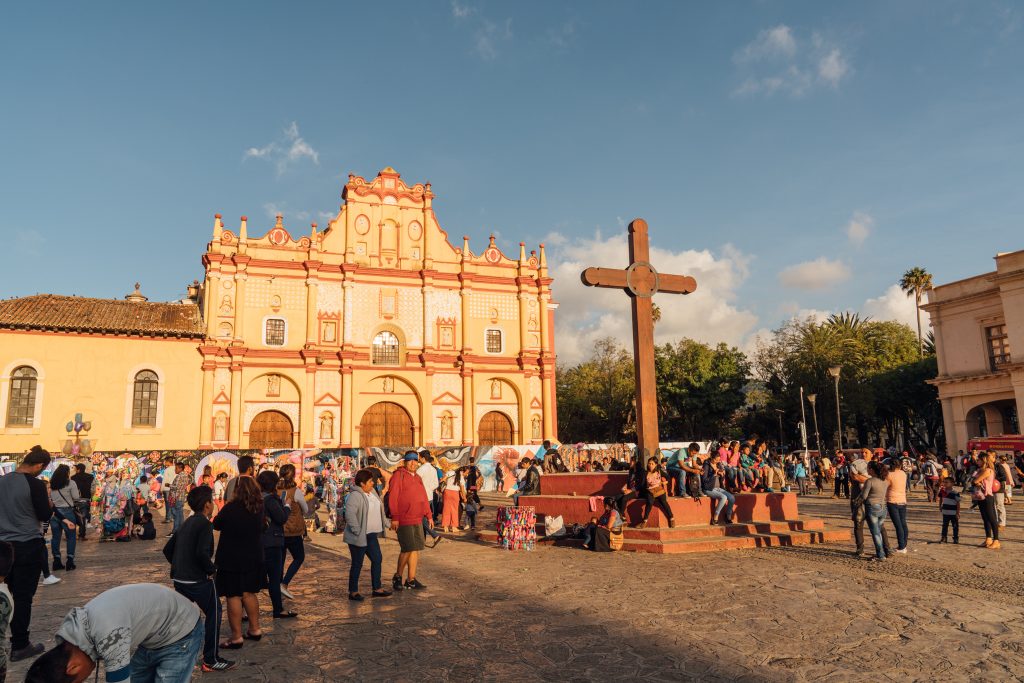
The goal for the first part of the trip was to distribute and implement water filters in rural schools throughout Chiapas. Globally, LifeStraw’s program operates by working with local governments and communities to implement the filters, train and educate teachers & students, and schedule follow-up visits to maintain the efficacy of the program. Since its inception, this program has provided over 1 million children with safe water in their schools. It’s funded by consumers, and you can learn more here.
We spent our first day in an orientation with LifeStraw, officials from the Mexican government, and representatives from the local distributor. Though the water is plentiful in Chiapas, the quality is poor, and the health department told us that only 35 of the 120 municipalities have a system to treat it. Throughout the day, we were given a brief history of the area, important cultural context, training on how to set up the filters, and tools for how to teach the students about safe water.
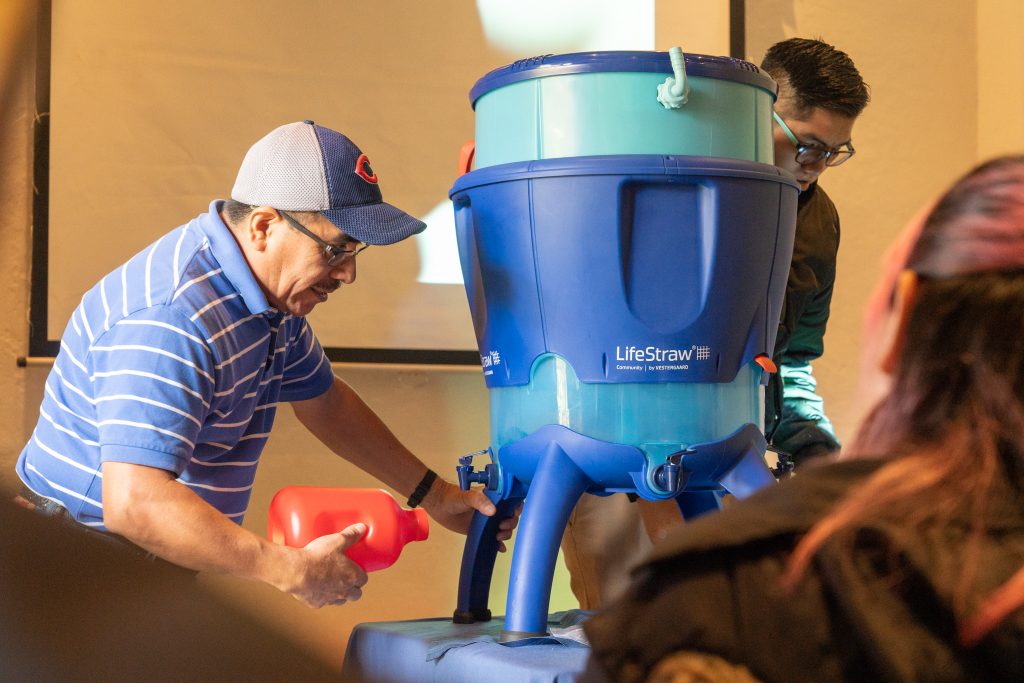
Note: I want to be clear about my role on this part of the trip. I was not there to “give back” personally, and I don’t deserve to be complimented on charity work, as I don’t believe this is what I was doing! I came in as a photographer and blogger to document and share this program and how it changes lives of kids and families in these communities. The way I see this, I had the opportunity to go see the work in person and share it with all of you, and I am grateful to be able to do this as part of my job.

Over the course of the following two days, my group visited six schools. The areas we were visiting were primarily Tzeltal and Tzotzil, two of the biggest Maya groups in the area. It is a huge and unfortunate misconception that Mayan people no longer exist. They do. They still speak their languages (each one unique), practice their traditions, and celebrate their cultures.
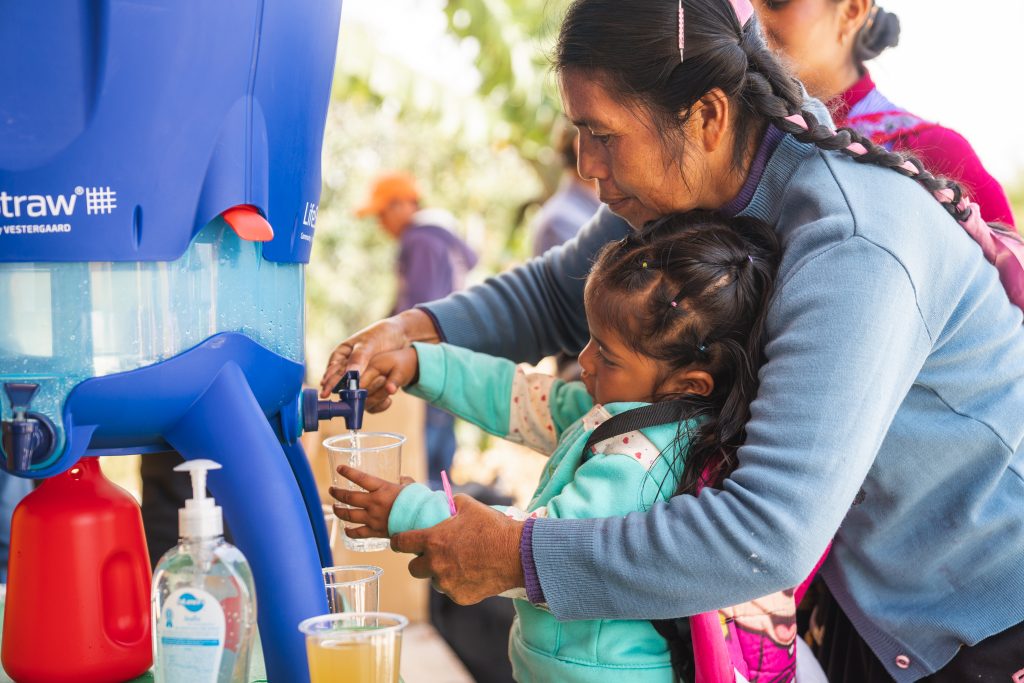
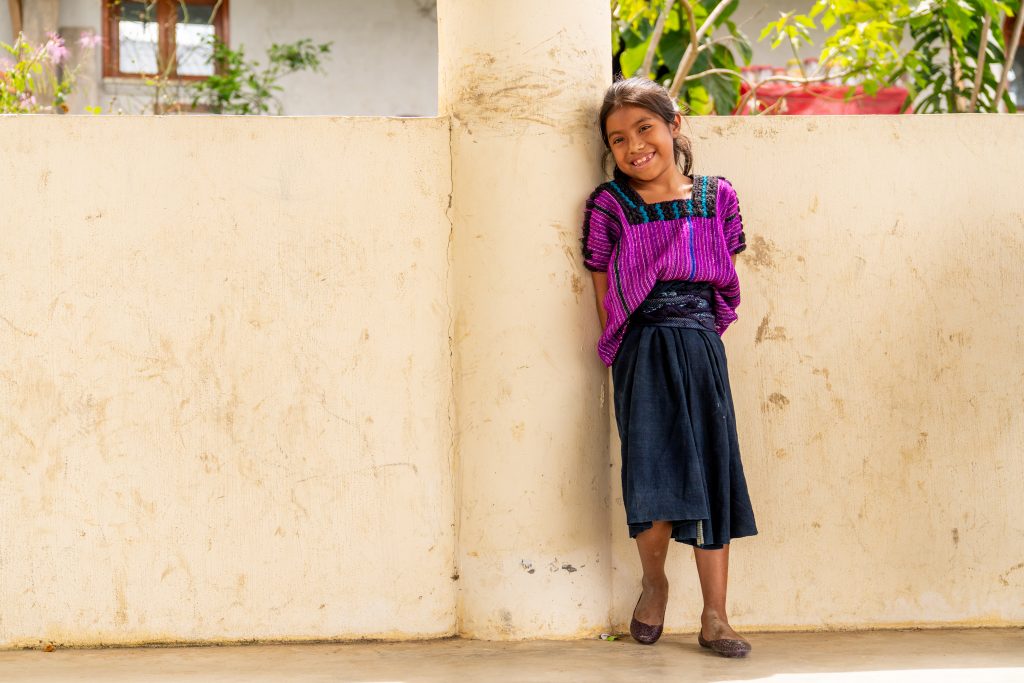
Our schedule went pretty similarly at each school. First, the filter was set up by Antonio from the local distributor. Next, Gerardo from the health department gave a training for teachers and parents on how to use and maintain the filter. Finally, the kids got to learn how to use the filter themselves, and try the water. Our local guide, Fíde, gave the talks in Tzeltal, the local language in most of these schools. We did visit a couple of Tzotzil schools, where Fíde had one of the teachers translate from Spanish.
Teachers, parents and kids all seemed excited about the filters–– “thank you for the water” is something I heard throughout the day from many people I interacted with. It was fun spending a few hours at these schools, playing games with the kids and talking with them.
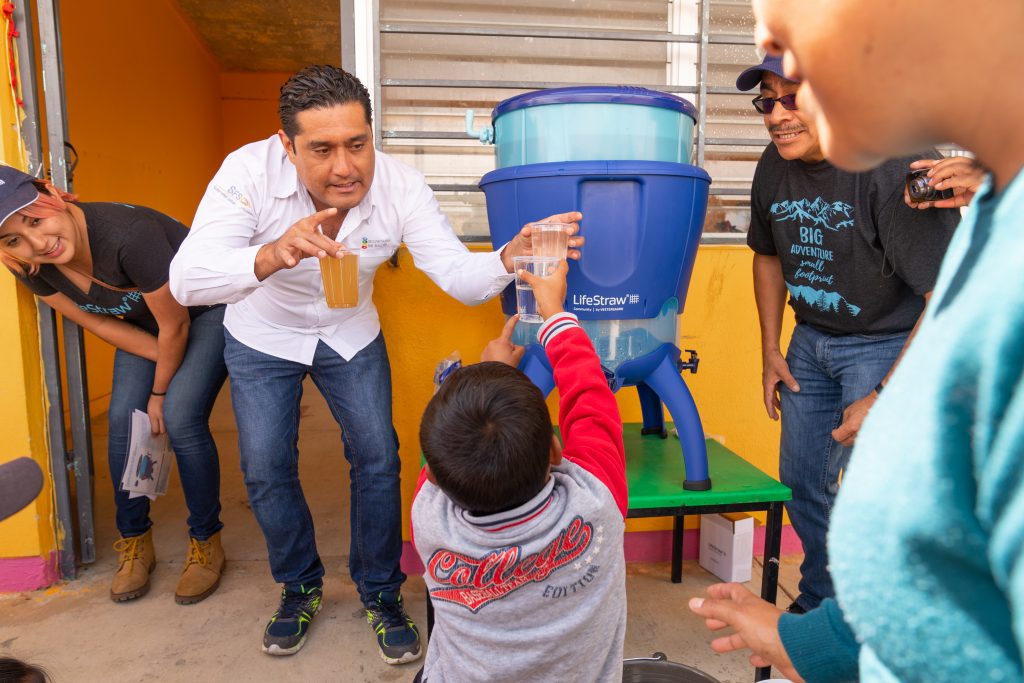
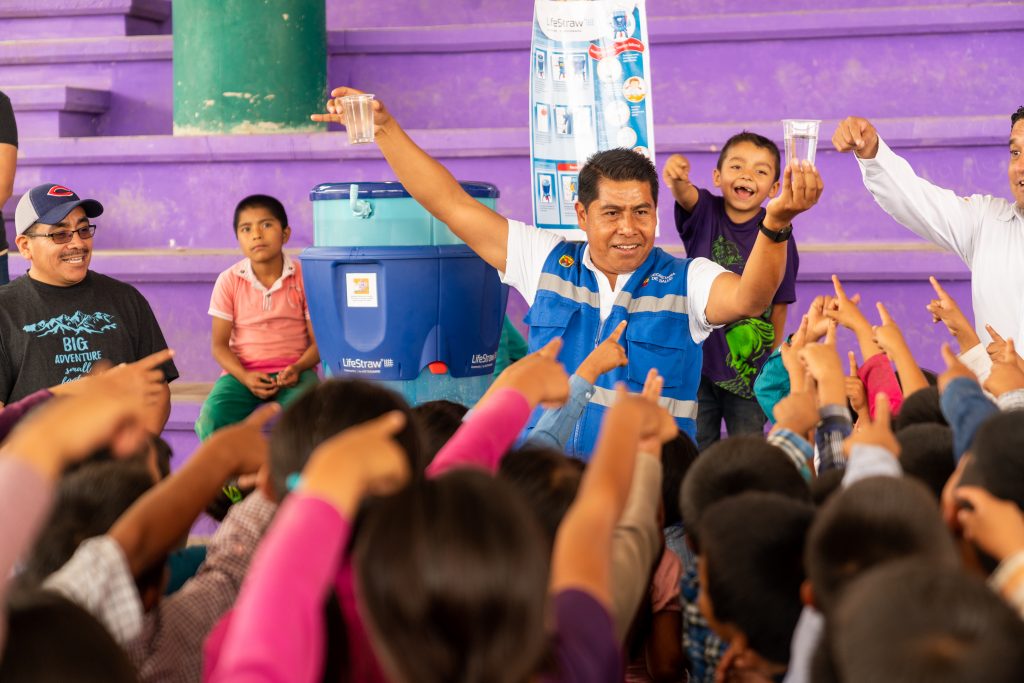
After spending a few days implementing filters and losing at multiple games of duck duck goose, it was time to head out. We drove toward Palenque to see some significant ancient Maya sites, as well as some stunning waterfalls, which seemed to exist in every possible direction!
Chiapas is home to the Zapatista uprising, which declared war on the Mexican government starting in 1994, demanding greater democratization and indigenous autonomy. Today, it’s not uncommon to encounter roadblocks or protests here–– and we did. It seemed to me like these communities are not supported by the government in the ways they’d been promised. If you travel in Chiapas, I would recommend doing some research on this history. Try to center the experiences of the Maya people themselves instead of the government or other entities that benefit from tourism.
Because of the road block, we headed a different way that took us through Toniná, a lesser-visited but fascinating ancient Mayan ruin. We only had a short time here before we had to get back on the road, but I was so impressed at the massive pyramid and ruins that showed how people lived during this period.
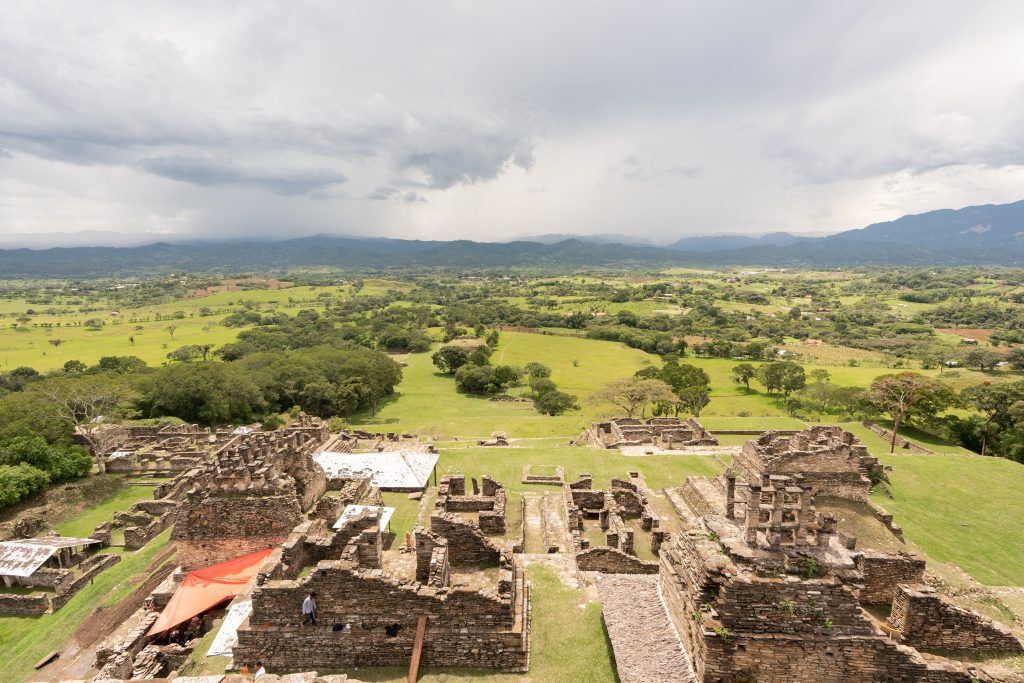
The next Mayan site we visited was Palenque, a captivating group of structures and one of the most popular destinations in Chiapas. Once you enter the site, the jungle opens up to the Tomb of the Inscriptions. We learned about King Pakal, who reigned from 603-683 AD and was buried inside this pyramid. We walked through the palace, stopping to climb pyramids and take photos.
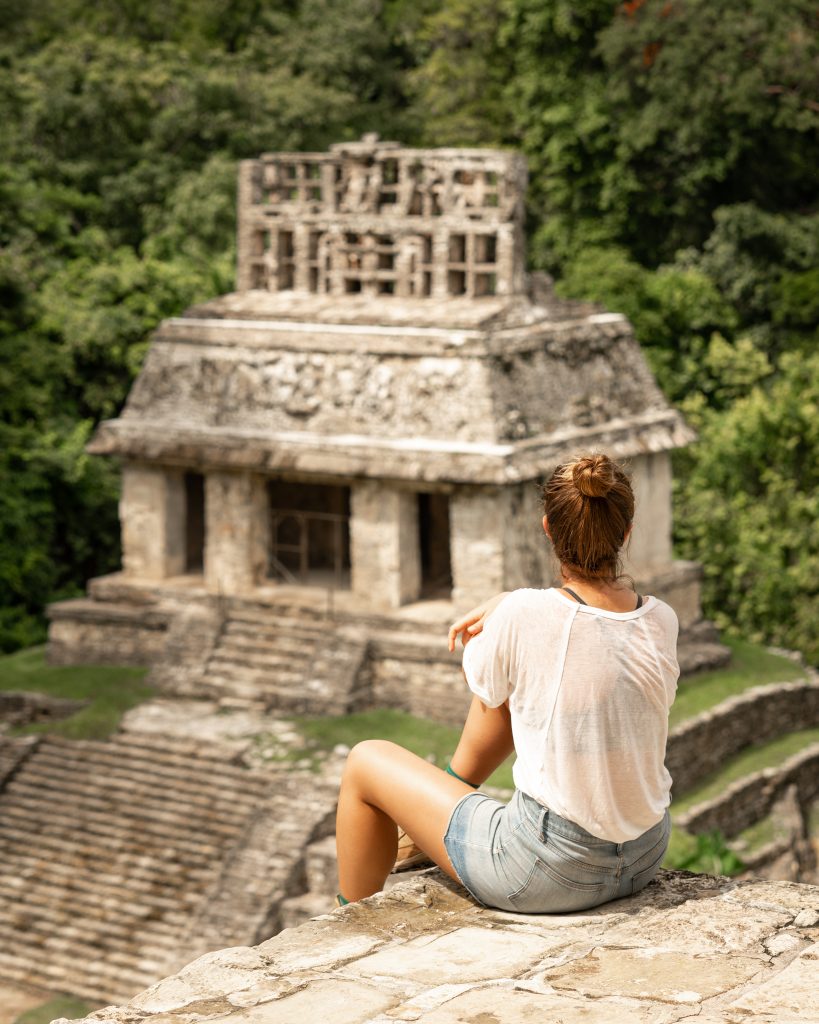
Definitely sweating, but with a good view.
The last ancient city we visited was Yaxchilán, located on the banks of the Usumacinta River, which runs on the border of Mexico and Guatemala. Yaxchilán feels like a hidden treasure in the jungle. Of course, it’s not exactly hidden as tourist boats come to visit every day (though significantly less than Palenque). Comparatively, this site has more tree coverage than the others. Dappled light pours across its courtyard, and howler monkeys roar from high above. If I had to pick a favorite site of the ones we visited, this would be it for its stunning setting.
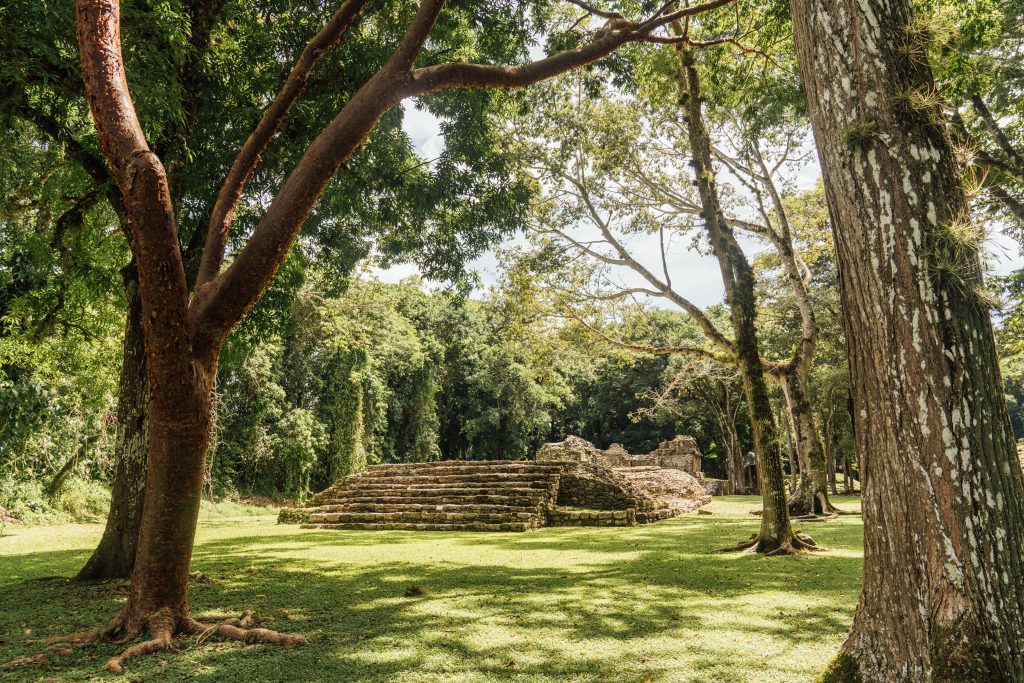
We visited several waterfalls on the trip, each was spectacular in its own way.
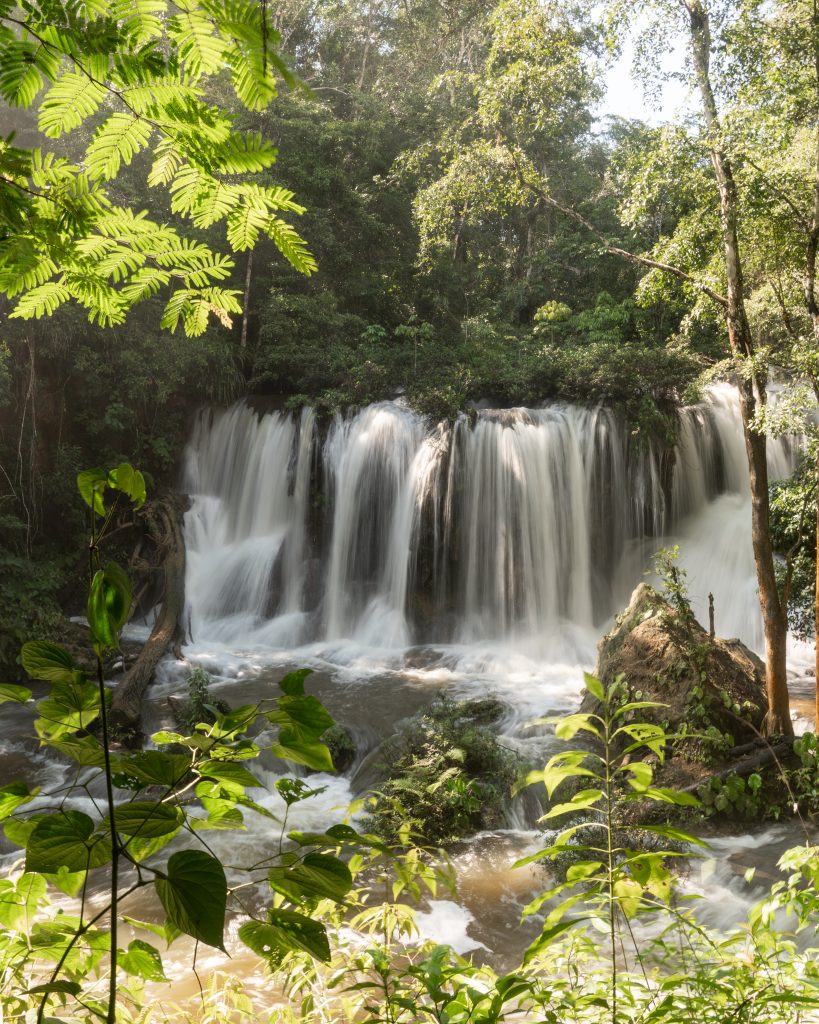
Our final activity of the trip was rafting. We drove another few hours to Lacanjá in the Lacandon Jungle. Some background that I feel is important to share: Land ownership in this area is a bit complicated. The Lacandon Reserve was not always Lacandon land, something I didn’t research much until after I got home. In 1971, a reserve was established, displacing the Tzeltal and Ch’ol families that lived there. The government appointed a small group of Lacandon families as tenants, which left non-Lacandon communities displaced and dependent on the government.
We met our Lacandon guides in the late morning and took off down the river. I wasn’t expecting such a beautiful or adventurous paddle, but this one delivered in all the best ways. This jungle is vast, lush, and stunning, and the river was a wonderful place to be after a few long days walking around in the heat and humidity. After an hour or so, we pulled our boats to the side and hiked to a massive waterfall. The sun hit at just the right angle, illuminating the mist.
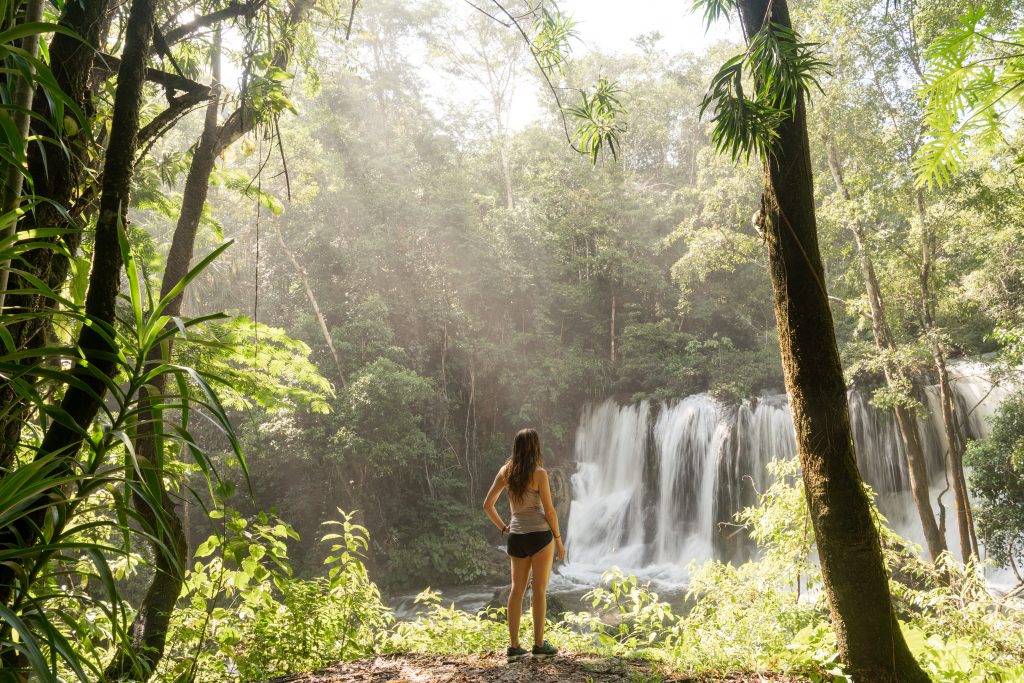
So much was packed into a week on this trip, and I am grateful for the opportunity to share all the parts of the experience!
Interested in supporting the LifeStraw Follow the Liters program? It is funded by consumers, so next time you need a water filter for backcountry pursuits or travel, consider buying a LifeStraw product in place of another brand.
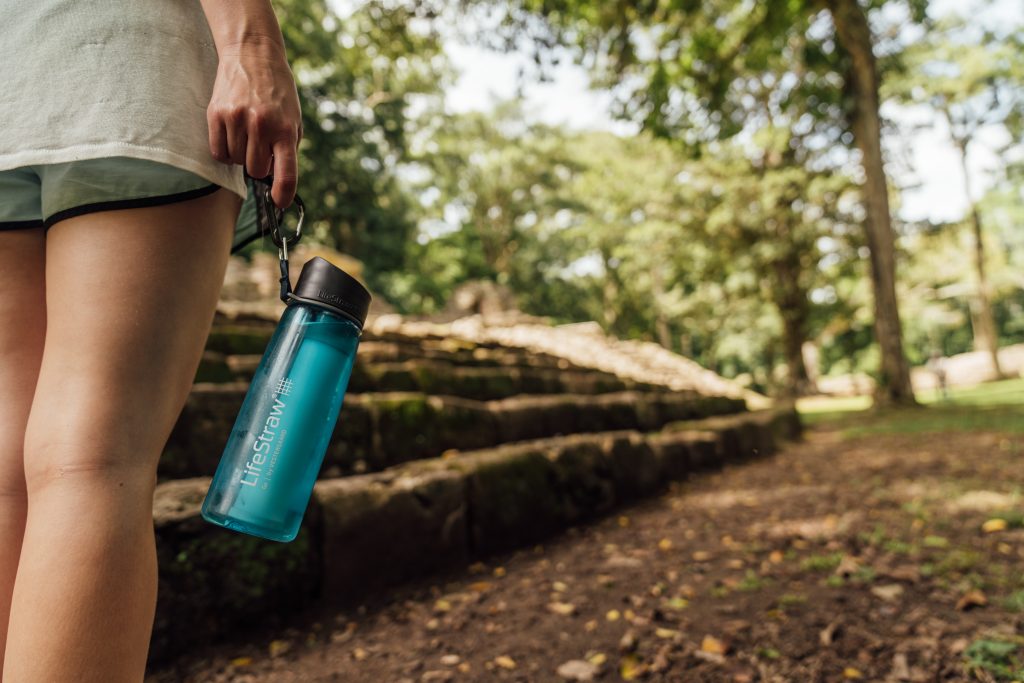
Best LifeStraw products for adventure travel:

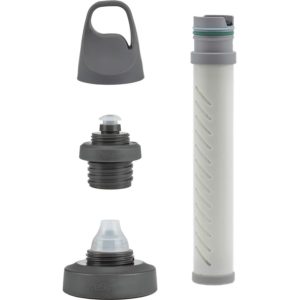
Left: The LifeStraw Go bottle. This bottle has a filter in it that takes out all the bad stuff–– 99.9999% of all bacteria, such as salmonella, cholera and E.coli, and 99.9% of all protozoa such as giardia and cryptosporidium. Shop at REI • Shop at Backcountry.
Right: The LifeStraw Universal Bottle Adapter. This is what I will use from now on when traveling. I wish I knew about it sooner! It’s a filter you can use with any standard Nalgene, Kleen Kanteen, or Hydro Flask water bottle. I personally prefer using stainless steel bottles, so this is perfect for me. Overall, having a filter like this is not only really convenient, it also means you are buying less single-use plastic water bottles. Shop at REI • Shop at Backcountry.
This post was published in partnership with LifeStraw, and contains affiliate links. If you click through and make a purchase, I may earn a small commission at no cost to you. As always, all thoughts and opinions are my own.
The post Adventure in Chiapas with LifeStraw appeared first on ERIN OUTDOORS.
A few weeks ago, LifeStraw invited me on a trip to document and share their Give Back (aka Follow the Liters) program. They are newly working with rural schools in Mexico (specifically Chiapas to start) to provide students with safe, clean water throughout the year.
I flew into the charming city of San Cristóbal de las Casas to meet the group. I could have spent weeks in San Cristóbal alone, with its cobblestone streets, colorful painted houses, and gorgeous churches. The lanterns, lights and streamers strung above the streets, live music pouring out of the restaurants, and a perfect mountain town climate made San Cristóbal a pleasure to base ourselves in for the first few days.

FOLLOW THE LITERS… WHAT IS IT?
The goal for the first part of the trip was to distribute and implement water filters in rural schools throughout Chiapas. Globally, LifeStraw’s program operates by working with local governments and communities to implement the filters, train and educate teachers & students, and schedule follow-up visits to maintain the efficacy of the program. Since its inception, this program has provided over 1 million children with safe water in their schools. It’s funded by consumers, and you can learn more here.
We spent our first day in an orientation with LifeStraw, officials from the Mexican government, and representatives from the local distributor. Though the water is plentiful in Chiapas, the quality is poor, and the health department told us that only 35 of the 120 municipalities have a system to treat it. Throughout the day, we were given a brief history of the area, important cultural context, training on how to set up the filters, and tools for how to teach the students about safe water.

Note: I want to be clear about my role on this part of the trip. I was not there to “give back” personally, and I don’t deserve to be complimented on charity work, as I don’t believe this is what I was doing! I came in as a photographer and blogger to document and share this program and how it changes lives of kids and families in these communities. The way I see this, I had the opportunity to go see the work in person and share it with all of you, and I am grateful to be able to do this as part of my job.

Over the course of the following two days, my group visited six schools. The areas we were visiting were primarily Tzeltal and Tzotzil, two of the biggest Maya groups in the area. It is a huge and unfortunate misconception that Mayan people no longer exist. They do. They still speak their languages (each one unique), practice their traditions, and celebrate their cultures.


Our schedule went pretty similarly at each school. First, the filter was set up by Antonio from the local distributor. Next, Gerardo from the health department gave a training for teachers and parents on how to use and maintain the filter. Finally, the kids got to learn how to use the filter themselves, and try the water. Our local guide, Fíde, gave the talks in Tzeltal, the local language in most of these schools. We did visit a couple of Tzotzil schools, where Fíde had one of the teachers translate from Spanish.
Teachers, parents and kids all seemed excited about the filters–– “thank you for the water” is something I heard throughout the day from many people I interacted with. It was fun spending a few hours at these schools, playing games with the kids and talking with them.


After spending a few days implementing filters and losing at multiple games of duck duck goose, it was time to head out. We drove toward Palenque to see some significant ancient Maya sites, as well as some stunning waterfalls, which seemed to exist in every possible direction!
TRAVELING CHIAPAS
Chiapas is home to the Zapatista uprising, which declared war on the Mexican government starting in 1994, demanding greater democratization and indigenous autonomy. Today, it’s not uncommon to encounter roadblocks or protests here–– and we did. It seemed to me like these communities are not supported by the government in the ways they’d been promised. If you travel in Chiapas, I would recommend doing some research on this history. Try to center the experiences of the Maya people themselves instead of the government or other entities that benefit from tourism.
Because of the road block, we headed a different way that took us through Toniná, a lesser-visited but fascinating ancient Mayan ruin. We only had a short time here before we had to get back on the road, but I was so impressed at the massive pyramid and ruins that showed how people lived during this period.

The next Mayan site we visited was Palenque, a captivating group of structures and one of the most popular destinations in Chiapas. Once you enter the site, the jungle opens up to the Tomb of the Inscriptions. We learned about King Pakal, who reigned from 603-683 AD and was buried inside this pyramid. We walked through the palace, stopping to climb pyramids and take photos.

Definitely sweating, but with a good view.
The last ancient city we visited was Yaxchilán, located on the banks of the Usumacinta River, which runs on the border of Mexico and Guatemala. Yaxchilán feels like a hidden treasure in the jungle. Of course, it’s not exactly hidden as tourist boats come to visit every day (though significantly less than Palenque). Comparatively, this site has more tree coverage than the others. Dappled light pours across its courtyard, and howler monkeys roar from high above. If I had to pick a favorite site of the ones we visited, this would be it for its stunning setting.

We visited several waterfalls on the trip, each was spectacular in its own way.

Our final activity of the trip was rafting. We drove another few hours to Lacanjá in the Lacandon Jungle. Some background that I feel is important to share: Land ownership in this area is a bit complicated. The Lacandon Reserve was not always Lacandon land, something I didn’t research much until after I got home. In 1971, a reserve was established, displacing the Tzeltal and Ch’ol families that lived there. The government appointed a small group of Lacandon families as tenants, which left non-Lacandon communities displaced and dependent on the government.
We met our Lacandon guides in the late morning and took off down the river. I wasn’t expecting such a beautiful or adventurous paddle, but this one delivered in all the best ways. This jungle is vast, lush, and stunning, and the river was a wonderful place to be after a few long days walking around in the heat and humidity. After an hour or so, we pulled our boats to the side and hiked to a massive waterfall. The sun hit at just the right angle, illuminating the mist.

So much was packed into a week on this trip, and I am grateful for the opportunity to share all the parts of the experience!
Interested in supporting the LifeStraw Follow the Liters program? It is funded by consumers, so next time you need a water filter for backcountry pursuits or travel, consider buying a LifeStraw product in place of another brand.

Best LifeStraw products for adventure travel:


Left: The LifeStraw Go bottle. This bottle has a filter in it that takes out all the bad stuff–– 99.9999% of all bacteria, such as salmonella, cholera and E.coli, and 99.9% of all protozoa such as giardia and cryptosporidium. Shop at REI • Shop at Backcountry.
Right: The LifeStraw Universal Bottle Adapter. This is what I will use from now on when traveling. I wish I knew about it sooner! It’s a filter you can use with any standard Nalgene, Kleen Kanteen, or Hydro Flask water bottle. I personally prefer using stainless steel bottles, so this is perfect for me. Overall, having a filter like this is not only really convenient, it also means you are buying less single-use plastic water bottles. Shop at REI • Shop at Backcountry.
This post was published in partnership with LifeStraw, and contains affiliate links. If you click through and make a purchase, I may earn a small commission at no cost to you. As always, all thoughts and opinions are my own.
The post Adventure in Chiapas with LifeStraw appeared first on ERIN OUTDOORS.
